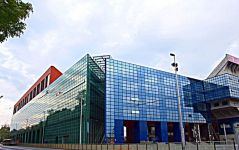Maksimir Stadium (Croatian: Stadion Maksimir, pronounced [ˈstadioːn maksimiːr]) is a multi-use stadium in Zagreb, Croatia. It takes its name from the surrounding neighbourhood of Maksimir. The venue is primarily the home of Dinamo Zagreb, the top club of the country with 22 league titles, but it is also the home venue of the Croatia national football team. First opened in 1912, it has undergone many revamps, and its current layout dates from a 1997 rebuilding. The stadium also sometimes hosts other events such as rock concerts.
History
The construction and the early years
With the rising popularity of the sport in Zagreb, the local football club HASK, which was one of the first multi-sports club in Croatia, decided to build a new stadium for their club. They bought the ground in the Svetice neighbourhood in Zagreb, which lays on the opposite side of the Maksimir Park, from the Archdiocese of Zagreb. HASK built a wooden stand with a capacity of 6,000, which was also the first ground with a proper stand in Zagreb at that time. The stadium was opened on 5 May 1912, and at the opening ceremony of the new stadium, HASK and their city rival, HSK Gradanski Zagreb, played several friendly matches to commemorate the opening.
Due to the close relationship and alliance of HASK and HSK Gradanski Zagreb and the latter one playing at the Stadion Koturaska, which was in a poor state, Gradanski also started playing their home matches at the new Stadium Maksimir.
On 26 May 1941, a representative of the Ustashe fascist government of the Independent State of Croatia addressed young Zagreb students at their meeting at the Maksimir Stadium, and at one point ordered the Serbian and Jewish students to be segregated, but the children disobeyed. Soon afterwards, in June 1941, rebel youths burned the stadium down. In 1977, a movie Operation Stadium was made to commemorate the segregation incident.
After World War II and the development
After World W
This page also has a version in other languages : Максимир Стадион (russian)
